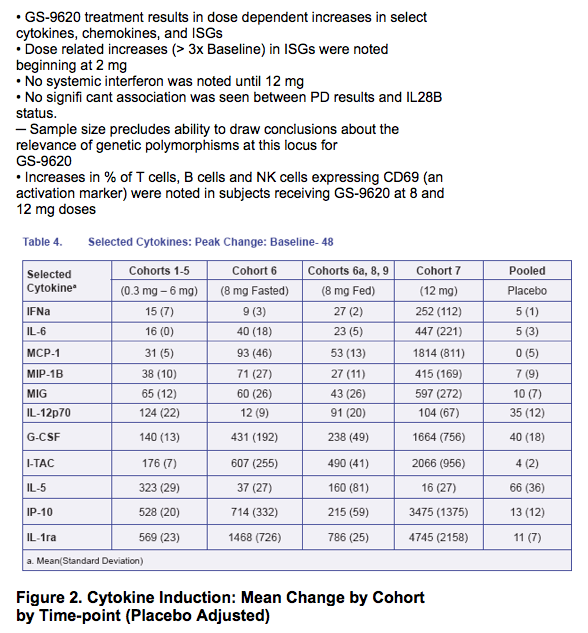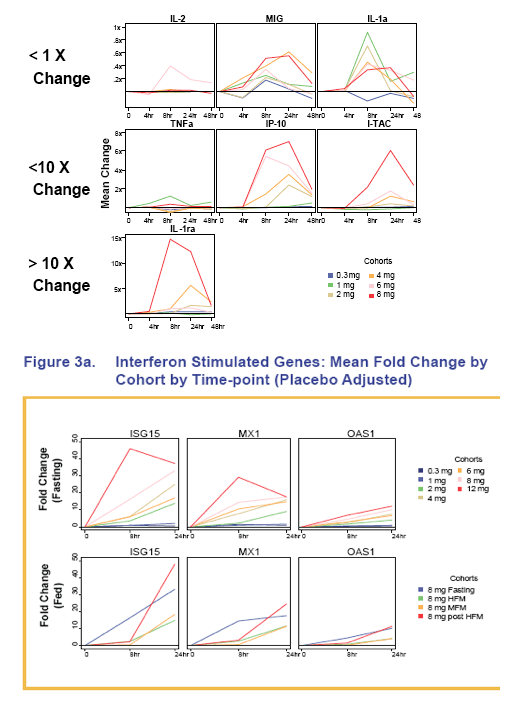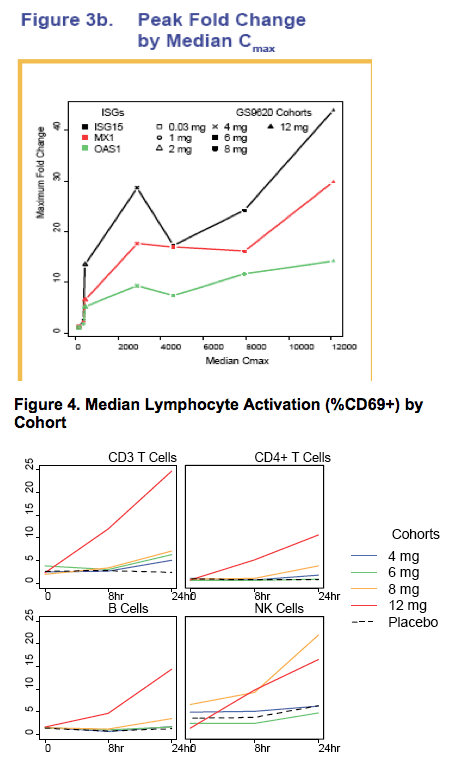 |
 |
 |
| |
A Phase-I, Randomized, Double-Blind, Placebo-Controlled Study To Evaluate The Safety, Tolerability, Pharmacokinetics and Pharmacodynamics of Single Escalating Oral Doses of GS-9620 In Healthy Subjects
|
| |
| |
Reported by Jules Levin
EASL 2011 Berlin Germany March 31-Apr 2
U Lopatin1, G Wolfgang1, R Kimberlin2, D Tumas1, M Cornprost1, G Chittick1, C Frey1, J Findlay1, C Ohmstede1, B Kearney1, C Barnes1, K Hirsch1, J McHutchison1
1Gilead Sciences, Inc., Foster City, CA, USA; 2Covance Inc., Evansville IN, USA
Introduction
· HCV and HBV infections have been shown to be amenable to therapy with Interferon-α
- Clinical "cure" rates with subcutaneous administration of Pegylated Interferons (PEG) are < 10% for HBV and only
~50% in HCV genotype 1 treated with PEG + Ribavirin (RBV)
- Unfortunately, many patients who might benefit from interferon are unwilling or unable to tolerate its side effects.
· Toll Like Receptor (TLR)-7 has been shown to be a sensor of viral nucleic acid, primarily expressed by plasmacytoid dendritic cells (1,2,3)
· TLR-7 agonists induce anti-viral signaling pathways (including interferons) in multiple animal species.
· TLR-7 agonists may serve as a component of therapy for viral hepatitis (4, 5)

Background
· GS-9620 is an oral small-molecule TLR-7 agonist
· Preclinical studies have demonstrated that GS-9620 has potent pharmacologic activity in vitro and in vivo (Abstract 1176)
· GS-9620 was found to have lasting effects on both HBV viral loads and viral antigens (S and E) in pre-clinical studies in infected chimpanzees (Abstract 1771) and woodchucks (Abstract 1790)
Objective
· The objective of Study GS-US-243-0101 was to investigate the safety, pharmacokinetics (PK), and pharmacodynamics
(PD) of single ascending doses of GS-9620 in healthy volunteers
Methods/Study Design
· In this double-blind, placebo-controlled study of 75 healthy human volunteers, single ascending doses of 0.3, 1, 2, 4, 6,
8 and 12 mg GS-9620 were administered in seven fasted and three food effect cohorts in a 6:2 ratio, (GS-9620:placebo)
· Patients were sequestered for three days following study drug administration, and returned for follow up on Days 5 and
14
· Plasma PK profi les were evaluated, and PD were assessed by Luminex evaluation of 28 serum cytokines, quantitative
evaluation of interferon-stimulated genes ISGs (MxA, OAS, ISG15) in PBMCs, and flow cytometry of circulating leukocytes (CD4, CD8 T cells, NK cells, and B cells)
· IL28B genotyping of the rs12979860 SNP was done using the ABI TaqMan allelic discrimination kit and the ABI7900HT Sequence Detection System (Applied Biosystems). A custom probe was designed by Applied Biosystems to genotype all samples

· GS-9620 was safe and well tolerated with single ascending doses through 12 mg
· There were no serious adverse events (SAEs) or individual subject discontinuations due to AEs or laboratory abnormalities
· A total of 49 treatment-emergent AEs in 15 subjects were reported as study drug related by the investigator
· Treatment-emergent AEs increased from 1 per cohort within the 2-mg, 4-mg and 6-mg dose groups to 11 within the 8-mg fasted dose group and 31 within the 12-mg dose group, suggesting a dose effect. Each of these events resolved during follow up
· The most common AE preferred terms were: headache (9 GS-9620 subjects and 2 placebo subjects), chills (6 GS-9620 subjects and 0 placebo subjects), and pyrexia (5 GS-9620 subjects and 1 placebo subjects)
· The only Grade 3 treatment-emergent AE was pyrexia, reported in 2 patients at 12 mg of GS-9620
· 7 subjects reported Grade 3 and 4 treatment-emergent laboratory abnormalities (5 Grade 3 events of hematuria, 1 Grade 3 event of elevated creatine phosphokinase, and 2 Grade 4 events of lymphopenia). Both Grade 4 laboratory abnormalities resolved by Day 5
· Mild decreases in platelet counts occurred, however these changes were not notable enough to be considered AEs


Pharmacokinetic Results
· Preliminary data for fasting PK parameters are provided in Table 2
· GS-9620 reached maximum plasma concentrations (Cmax) between 1.5 hours and 6.0 hours after dosing and declined with a terminal half-life (t1/2) between 15 and 25 hr
· GS-9620 exhibited approximately dose proportional kinetics with a trend towards great than proportional exposure at higher doses
· GS-9620 exhibited moderate intersubject variability in plasma PK
· GS-9620 administered with food (simultaneously w/ moderate- or a high-fat meals or 4 hours after a high-fat meal) resulted in ~ 30 to 50% lower drug exposures (data not presented)
Figure 1. Mean GS-9620 Plasma Levels in Healthy Volunteers (Fasted)


· GS-9620 treatment results in dose dependent increases in select cytokines, chemokines, and ISGs
· Dose related increases (> 3x Baseline) in ISGs were noted beginning at 2 mg
· No systemic interferon was noted until 12 mg
· No signifi cant association was seen between PD results and IL28B status.
- Sample size precludes ability to draw conclusions about the relevance of genetic polymorphisms at this locus for
GS-9620
· Increases in % of T cells, B cells and NK cells expressing CD69 (an activation marker) were noted in subjects receiving GS-9620 at 8 and 12 mg doses


References
1. Eur Cytokine Netw. 2000 Sep;11(3):362-71
2. J Exp Med. 2001 Sep 17;194(6):863-9.
3. Genes Immun. 2001 Oct;2(6):349-55.
4. Nat Immunol. 2002 Feb;3(2):196-200.
5. Antimicrob Agents Chemother. 2007 Aug;51(8):2969-78
|
| |
|
 |
 |
|
|